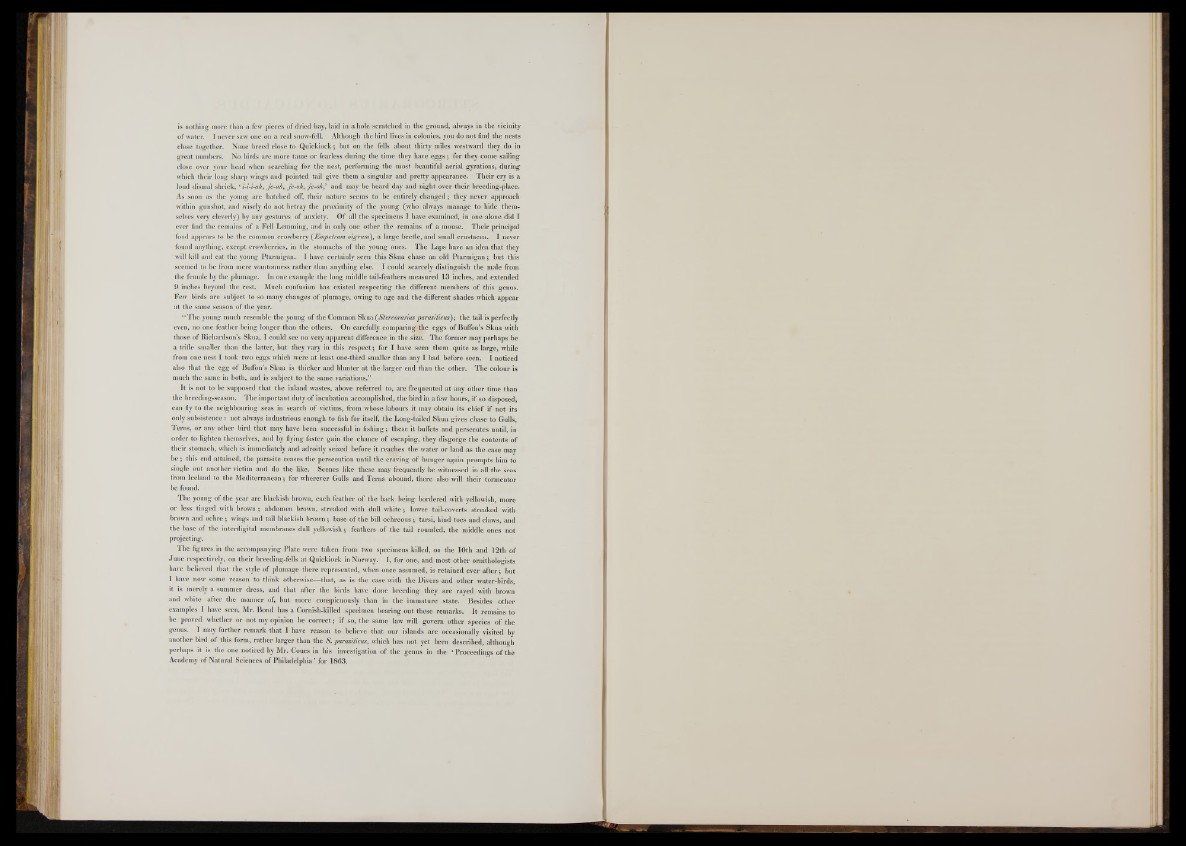
is nothing more than a few pieces of dried hay, laid in a hole scratched in the ground, always in the vicinity
of water. I never saw one on a real snow-fell. Although the bird lives in colonies, you do not find the nests
close together. None breed close to Quickiock; but on the fells about thirty miles westward they do in
great numbers. No birds are more tame or fearless during the time they have eg g s; for they come sailing
close over your head when searching for the nest, performing the most beautiful aerial gyrations, during
which their long sharp wings and pointed tail give them a singular and pretty appearance. Their cry is a
loud dismal shriek, ‘ i-i-i-ah, je-ah, je-oh, je-oh,’ and may be heard day and night over their breeding-place.
As soon as the young are hatched off, their nature seems to be entirely changed; they never approach
within gunshot, and wisely do not betray the proximity of the young (who always manage to hide themselves
very cleverly) by any gestures of anxiety. Of all the specimens I have examined, in one alone did I
ever find the remains of a Fell Lemming, and in only one other the remains o f a mouse. Their principal
food appears to be the common crowberry ('Empetrum nigrum), a large beetle, and small crustacea. I never
found anything, except crowberries, in the stomachs o f the young ones. The Laps have an idea that they
will kill and eat the young Ptarmigan. I have certainly seen this Skua chase an old Ptarmigan; but this
seemed to be from mere wantonness rather than anything else. I could scarcely distinguish the male from
the female by the plumage. In one example the long middle tail-feathers measured 13 inches, and extended
9 inches beyond the rest. Much confusion has existed respecting the different members o f this genus.
Few birds are subject to so many changes o f plumage, owing to age and the different shades which appear
at the same season o f the year.
“ The young much resemble the young o f the Common Skua {Stercorarius parasiticus)-, the tail is perfectly
even, no one feather being longer than the others. On carefully comparing the eggs o f Buffon’s Skua with
those o f Richardson’s Skua, I could see no very apparent difference in the size. The former may perhaps be
a trifle smaller than the latter, but they vary in this respect; for I have seen them quite as large, while
from one nest I took two eggs which were at least one-third smaller than any I had before seen. I noticed
also that the egg o f Buffon’s Skua is thicker and blunter at the larger end than the other. The colour is
much the same in both, and is subject to the same variations.”
It is not to be supposed that the inland wastes, above referred to, are frequented at any other time than
the breeding-season. The important duty o f incubation accomplished., the bird in a few hours, if so disposed,
can fly to the neighbouring seas in search o f victims, from whose labours it may obtaiu its chief if not its
only subsistence : not always industrious enough to fish for itself, the Long-tailed Skua gives chase to Gulls,
Terns, or any other bird that may have been successful in fishing; these it buffets and persecutes until, in
order to lighten themselves, and by flying faster gain the chance of escaping, they disgorge the contents o f
their stomach, which is immediately and adroitly seized before it reaches the water or land as the case may
b e ; this end attained, the parasite ceases the persecution until the craving of hunger again prompts him to
single out another victim and do the like. Scenes like these may frequently be witnessed in all the seas
from Iceland to the Mediterranean; for wherever Gulls and Terns abound, there also will their tormentor
be found.
The young o f the year are blackish brown, each feather o f the back being bordered with yellowish, more
or less tinged with brown ; abdomen brown, streaked with dull white; lower tail-coverts streaked with
brown and ochre; wings and tail blackish brown; base o f the bill ochreous; tarsi, hind toes and claws, and
the base of the interdigital membranes dull yellowish; feathers of the tail rounded, the middle ones not
projecting.
The figures in the accompanying Plate were taken from two specimens killed, on the 10th and 12th of
June respectively, on their breeding-fells at Quickiock in Norway. I, for one, and most other ornithologists
have believed that the style of plumage there represented, when once assumed, is retained ever after; but
I have now some reason to think otherwise—that, as is the case with the Divers and other water-birds,
it is merely a summer dress, and that after the birds have done breeding they are rayed with brown
and white after the manner of, but more conspicuously than in the immature state. Besides other
examples I have seen, Mr. Bond has a Cornish-killed specimen bearing out these remarks. It remains to
be proved whether or not my opinion be correct; if so, the same law will govern other species o f the
genus. I may further remark that I have reason to believe that our islands are occasionally visited by
another bird of this form, rather larger than the S . parasiticus, which has not yet been described, although
perhaps it is the one noticed by Mr. Coues in his investigation o f the genus in the ‘Proceedings o f the
Academy o f Natural Sciences o f Philadelphia ’ for 1863.